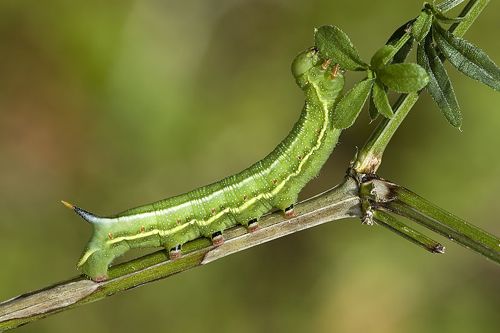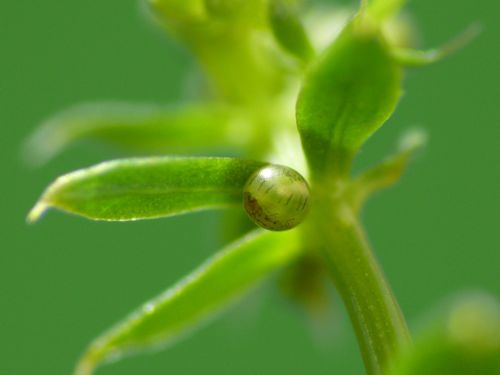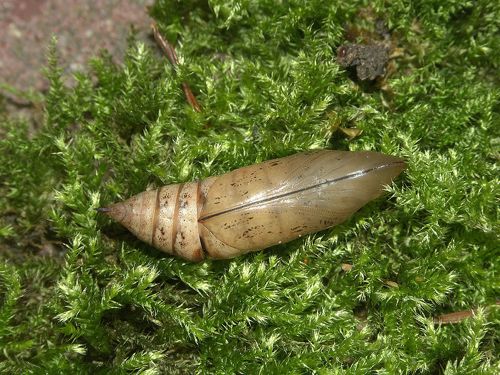A hummingbird ? A butterfly ? No – it is a moth!
by Anna Stöckl
 A hummingbird hawkmoth in its typical hovering position feeding from a flower.
A hummingbird hawkmoth in its typical hovering position feeding from a flower.
You have probably seen this little fellow before. The hummingbird hawkmoth (Fr: le moro sphinx, Cat: el bufaforats), scientifically Macroglossum stellatarum, is a common inhabitant of Southern Europe, and thus also of Languedoc-Roussillon.
Being responsible for a good number of “hummingbird” sightings in central Europe, it is actually a day active moth, one of very few exceptions from a group of insects which generally prefer the shelter of the night to roam around.

Hummingbird hawkmoths live a life not so unlike that of a butterfly: they spend most of their day looking for nectar to suckle on, which they do by hovering in front of the flowers, rather than landing on them like many of their winged insect relatives—hence their name hummingbird hawkmoth.
Hovering in mid-air, they insert their long tongue, called a proboscis, into the flower’s nectary and take a good sip. These little buzzers are not only peculiar in being one of the very few day active hawkmoth species, but they are also special in some other respects as well.

For one thing, they have a favourite colour: blue. Given the choice, a blue or a purple flower will be preferred to white or yellow.
Not only are they quite picky in their choice of flowers, but also in the type of plant they lay their eggs on: hummingbird hawkmoths exclusively lay eggs on plants of the genus Galium, some species of which are commonly known as bedstraw (Fr: caille-lait, Cat: espunyidella). After a few days, tiny green caterpillars about 2 mm in length will hatch from the eggs and, with an appetite much larger than their size would suggest, they eat their way through their hostplant, growing to about 4-5 cm long in 3 weeks.

When they are full-grown it is time for the caterpillars to find a quiet and safe spot on the ground, where they spin themselves a little shelter, and turn into a pupa. In the pupa, the metamorphosis from caterpillar to adult moth takes place over the next two weeks, after which a new hummingbird hawkmoth ecloses—ready to set out to find a bouquet of blue flowers.
The hummingbird hawkmoth is unusual in one more way: unlike most other moths, it does not hibernate as a pupa, but as an adult. Moths find crevasses or spots on the ground when temperatures drop and stay there over winter, to emerge when it gets warmer with the beginning of spring, to feed and start a new generation of hummingbird hawkmoths.

Because they don’t survive harsh winter temperatures, hummingbird hawkmoths are annual inhabitants only in the South of Europe—however, when temperatures increase in spring, parts of the population venture out and start a journey north: across the alps to central Europe. The South of England is a rare exception—the mild climate allows the hummingbird hawkmoth to overwinter and live there the whole year.
HELP PLEASE
Those adorable moths are not only a joy to watch in the garden or out on nature walks, but they are also a very interesting subject for scientists. In my PhD thesis I seek to understand the adaptations of the visual system of insects to different light environments, to gain general insights into how a visual system (or our technical equivalent, a camera) can become as light sensitive as possible in dim light.
I mainly study the visual system of night active hawkmoths, to find the special characteristics that enable them to see well at night. The hummingbird hawkmoth, however, has a special place in my studies, being the exception from the rule – a moth, that has evolved from a night-active ancestor to an animal active in bright daylight.
I am conducting a study to see whether hummingbird hawkmoths are relying on their sense of vision more strongly than night active hawkmoths, which tend to use their sense of smell to find and remember flowers, because vision is more reliable during the day than during the night? I therefore compare the degree to which hummingbird hawkmoths and nocturnal hawkmoths use visual and olfactory cues to find and remember a food source.
There is only one problem: I am a PhD student at the University of Lund, in Southern Sweden, and hummingbird hawkmoths very rarely migrate so far north, and if so in very small numbers.
We can keep a colony of these moths in our animal facilities, but we need to obtain a founder population of moths from their home areas. I am therefore planning to visit Langedoc-Roussillon at the end of May to collect eggs of the hummingbird hawkmoth to take up to the North and breed a colony there; to study their flower learning behaviour in comparison to nocturnal hawkmoths.
And this is where you, readers of this article, can help me and my project: I need to find the spots that the moths visit regularly, as well as places where their host plant Galium grows, to have a chance of finding eggs for my colony. Be assured that the number of eggs I am going to take is not affecting the local population of moths—a single moth can lay up to 200 eggs, more than enough to start my colony! Also, hummingbird hawkmoths are numerous, and thus their populations are not in danger, or under protection.
I am very grateful for any information on growth of Galium in Languedoc-Roussillon as well as of places where hummingbird hawkmoths can be found reliably. You can contact me via anna.stockl@biol.lu.se if you have information on Macroglossum or further questions. But most importantly, enjoy watching these beautiful moths whenever you can and remember what an exceptional insect they are!
| Online resources on hawkmoths: http://tpittaway.tripod.com/sphinx/m_ste.htm and on my research: http://www.biology.lu.se/anna-stockl Image credits: |


I video filmed one in my garden this morning 20th March 2024 taking nectar from blue hyacinths, about 25 seconds.
A hummingbird hawk moth is my shop in Sherborne today! I’ve been desperately trying to get him out, but with no luck so far. Will keep trying. Lovely low humming noise when he flys past.